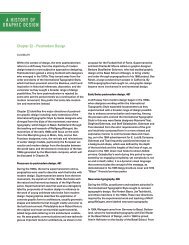Week 2 National Visions within a Global Dialogue - A History of ...
Week 2 National Visions within a Global Dialogue - A History of ...
Week 2 National Visions within a Global Dialogue - A History of ...
You also want an ePaper? Increase the reach of your titles
YUMPU automatically turns print PDFs into web optimized ePapers that Google loves.
A HISTORY OFGRAPHIC DESIGNsented, including illustration, painting and assemblage,photography, montage, and the purely typographic. Techniquesrange from traditional, digital, and a combination<strong>of</strong> the two.The conceptual book cover, page 509Charles I. (Chip) Kidd <strong>of</strong> Alfred A. Knopf engages readerswith elusive, visual puns on his book jackets, such as his1998 solution for Turn <strong>of</strong> the Century, on which he useda mirror image to depict the subject. Katsumi Asaba,founder <strong>of</strong> Katsumi Asaba Design Office, combinescontemporary graphic design with ancient writing systems,as demonstrated on the book jacket for Spy Sorge,which incorporates a surviving pictographic script calledDongba (Tompa). Paprika, founded by Joanne Lefebvreand Louis Gagnon, achieve a sense <strong>of</strong> unity in the jacketdesigns for Les Allusifs, a Montreal-based publisher.Illustrated by Alain Pilon, the jackets are intellectuallychallenging and stand apart from those <strong>of</strong> larger andmore commercially aggressive concerns.Design in Spain, Portugal, and Latin America, page 509Spain and PortugalSpain and Portugal share analogous and at times parallelheritages, which have only recently been critically examinedin the context <strong>of</strong> design. From the 1930s through the1970s, both countries were, to a large extent, cut <strong>of</strong>f fromthe rest <strong>of</strong> Europe through repressive governments,political turmoil, and financial misfortune; Europeanmodernism and Russian constructivism had little influencedduring this era. Design from both countries sharesimilar aesthetic qualities: tranquil, charming, and colorful.It suggests the Iberian culture, including opulentlytextured architecture, local arts and crafts, and modernistart including the work <strong>of</strong> Gaudi, Picasso, Miró, Joséde Almada Negreiros, and Amadeo de Souza. In Spain,these qualities are reflected in the design work <strong>of</strong> EmilioGil, author and designer <strong>of</strong> the book Pioneers <strong>of</strong> SpanishGraphic Design; Pablo Martín, whose work, while globalin scope, reflects the Spanish design heritage—brightwith color, cheerful, and witty; the prolific Manuel Estrada,who strives for a balance between reflection, feeling,and intuition in his design; Isidro Ferrer, whose sculptural,whimsical, and humorous book covers reflect hisbackground and studies in drama; and Pep Carrio, whointegrates his work as an illustrator and plastic artist intodesign as it is applied to brand images, corporate communicationsand, most notably, exhibitions and culturalactivities. In Portugal, the Iberian aesthetic is reflected inthe work <strong>of</strong> Sebastião Rodrigues, generally consideredthe father <strong>of</strong> Portuguese design; Henrique Cayette, artdirector <strong>of</strong> Egoísta magazine; João Machado, whoseposters are typified by exuberant colors and a playfularrangement <strong>of</strong> geometric elements; and the design firmAlva, who is involved in the promotion <strong>of</strong> cultural eventsand organizations in historic Lisbon, among other designactivities.Latin AmericaThe Mexican design movement draws on European andpre-Columbian cultures as sources <strong>of</strong> inspiration. Mexicandesigner Félix Beltrán was born in Havana, Cuba,where he designed social and political posters about theCuban Revolution, indigenous art, public safety, and thenew economy before moving to Mexico. He works as aprinciple designer at Beltrán-Asociados Studio, wherehis work follows the traditions <strong>of</strong> the international style.Luis Almeida works primarily as an editorial designerin Mexico City. His work is direct and confrontational,as seen in his 2004 “Quixote” and “Cervantes XXI”posters. German Montalvo’s poster celebrating the poetJosé Gorostiza is in the Polish conceptual poster tradition,as is the work <strong>of</strong> Gabriela Rodriguez, who designsfor political, social, and cultural causes, and AlejandroMagallanes, who uses collage and freehand drawingwith wit and intellectual prowess as in his 2002 poster“Reflexiones en torno al libro” (Reflections on the Book).Brazilian designer, Rico Lins, and the Argentinian designer,Rubén Fontana, have been at the vanguard <strong>of</strong> SouthAmerican design for decades. Lins, highly acclaimedfor his pioneering work in graphic design, has exhibitedinternationally, including solo museums at the CentrePompidou in Paris and the Museum <strong>of</strong> Modern Art inNew York. Fontana, head <strong>of</strong> the innovative design firmFontana Diseño, has been highly influential in increasingpublic awareness <strong>of</strong> graphic design throughout Argentina;he introduced the first typography course at theUniversidad de Buenos Aires and for twenty years wasthe publisher <strong>of</strong> the magazine TipoGráfica.A new aesthetic <strong>of</strong> modern Chinese graphic design, page519Since 1980, China has embraced international commerceand the resulting confluence <strong>of</strong> intellectual, economic,social, and political forces have modernized the country.In parallel, a dramatic change has occurred in Chinesedesign education programs, which have begun toemphasize modern Western design movements overfive-thousand-year-old Chinese artistic and calligraphic
















